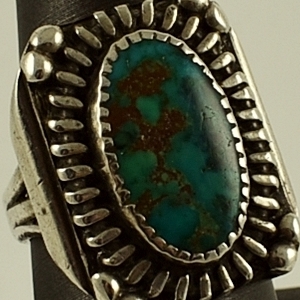When looking at the kind of jewelry we all love, historic American Indian silverwork, it would be hard to overstate the importance of the bezel in dating a piece. Bezels, which are technically silver strips wrapped around a stone to hold it in place on a silver base, have changed quite a bit over time, as the tools, materials and techniques available to silversmiths have become more and more advanced.
Early on, the big problem facing Indian silversmiths was how to encircle a stone at an angle without folding the thin silver of the bezel. (Imagine wrapping a strip of paper around an orange without there being gaps or folds--try it sometime! It is basically impossible.) To solve this problem, early smiths would usually crimp or notch the silver, which looked something like this (circa 1900):
Later, some smiths would notch the silver all the way around the stone, creating what we call a sawtooth bezel (circa 1915).
As you can see, this neatly solved the problem of having the thin silver fold over or form gaps. And the visual effect was quite interesting, so much so that some smiths continued to use the sawtooth bezel well into the 1940s, after it was no longer necessary. Here is a ring with a sawtooth bezel from the 1930s.
To make a smooth bezel before 1920 was a real challenge, but could be done if the stone had a high dome and the silver was left somewhat thick. Here is an example from circa 1915:
You can see that the bezels are not perfectly smooth, but considering the early date, the smith did as good a job as he possibly could have managed.
By 1935, the introduction of commercially made bezels had made smooth bezels possible, though it would be some time before smiths in the Southwest were universally able to manipulate them with near-perfect dexterity. Here is a ring with what are probably early commercial bezels--note that they are not perfectly done (circa 1925-30):
And finally, when the use of commercial bezels became the rule rather than the exception, a smooth bezel that was just about perfect was not only possible, but commonplace. Here is an example by Fred Peshlakai from circa 1950:
The moral of the story is, know your bezels. They can be your best friend in dating older Southwest Indian silverwork.
Tuesday, September 19, 2017
Subscribe to:
Post Comments (Atom)






No comments:
Post a Comment